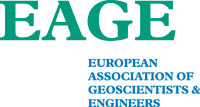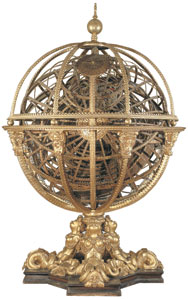May 2002 Vol. 223 No. 5
Feature Article
|
EAGE Preview
EAGE will make integration of geosciences its theme
 |
 |
Armillary Sphere as symbol of the Conference. It is an astronomical instrument, representing a dynamic model of the universe according to the Ptolemaic concept, having the earth to its center.
|
|
|
A preview of the European Association of Geoscientists & Engineers technical program, exhibition and annual meeting, Florence, Italy, May 26 – 30
One of EAGE’s most valuable traditions is that its Annual Conference and Exhibition travels around the continent of Europe. The 64th EAGE Conference and Exhibition is being held May 27 – 30, 2002. The venue will be the ancient Fortezza da Basso Exhibition Complex, right in the middle of the magnificent city of Florence, Italy. The event is being organized to provide a forum to discuss and further the state of the art of disciplines in our industry.
The conference theme, "Toward Integration of Geosciences," underlines an intention to bring together geoscientists who are active in different disciplines. This theme is well-suited to Florence and the Tuscany region, which, in the Renaissance period, was an important scientific center and gave rise to several eclectic scientists paramount for the advancement of knowledge, such as Dante, Michelangelo, Galileo Galilei and Leonardo da Vinci, who was not nly an extraordinarily talented painter, but also an engineer and geologist of great vision and originality. Almost all of the major players in the E&P business have ensured their participation in the Exhibition, where the most up-to-date tools and technologies will be availableWfor evaluation. Further information can be found at: www.eage.org and +31 30 6354066. 
| |
Technical Program |
|
| |
Poster sessions |
|
| |
This year, poster sessions will be presented differently from past years. Poster presentations will have the same 25-min. time slots as the oral presentations. Each poster will be grouped by session in separate areas and will be on display for one full day. |
|
| |
Workshops |
|
| |
Sunday, May 26 |
|
| |
W1: Turbidites: Models and problems |
09.00–17.00 hrs. |
|
| |
W2: Geodynamics of the Mediterranean and impact on hydrocarbon exploration |
09.00–17.00 hrs. |
|
| |
W3: Multidimensional geological modeling: From cutting edge research to application in the field |
09.00–17.00 hrs. |
|
| |
W4: High-density, high-resolution seismic velocity analysis: Where are we and for what benefit? |
09.00–12.30 hrs. |
|
| |
W5: Integrating reservoir engineering with geology and geophysics: Uncertainties and reservoir monitoring |
09.00–17.00 hrs. |
|
| |
W6: Improving high resolution |
09.00–17.00 hrs. |
|
| |
Monday, May 27 |
|
| |
W7: Carbonate reservoirs of Perithetys |
13.30–17.00 hrs. |
|
| |
W8: Geoscience education and knowledge management: What is new? |
09.30–17.00 hrs. |
|
| |
W9: Geophysics for cultural heritages: Payoffs for archaeology |
09.00–17.00 hrs. |
|
| |
Symposium |
|
| |
Monday, May 27 |
|
| |
New technologies for land monitoring: From digital elevation models to subsidence estimation |
09.00–17.00 hrs. |
|
| |
Field trips |
|
| |
Friday, May 24 through Sunday, May 26 |
|
| |
F1: Cretaceous to Miocene platform carbonates along the Matese-Murge transect |
|
|
| |
Saturday, May 25 |
|
| |
F2: Northern Appennines: Pelagic and Tertiary foredeep deposits |
|
|
| |
Friday, May 31 |
|
| |
F3: Larderello geothermal areas and facilities |
|
|
| |
Distinguished Instructor Short Course (DISC) |
|
| |
Monday, May 27 |
|
| |
Dr. Leon Thomsen |
|
|
| |
Understanding seismic anisotropy in exploration and exploitation |
09.00–17.00 hrs. |
|
|
| |
Technical sessions schedule |
Time |
Location |
|
| |
May 28 |
|
|
|
| |
4D Time Lapse Analysis |
10.20–11.35 |
Poster area |
|
| |
Acquisition |
08.30–11.35 |
Lecture Room A |
|
| |
Anisotropy |
08.30–9.45 |
Poster area |
|
| |
AVO and Inversion 1 |
08.30–11.35 |
Poster area |
|
| |
AVO and Inversion 2 |
13.45–16.50 |
Lecture Room G |
|
| |
Best of SEG |
13.45–16.25 |
Lecture Room A |
|
| |
Carbonate Reservoirs |
08.30–11.35 |
Lecture Room F |
|
| |
CO2 Sequestration & Gas Storage |
13.45–16.50 |
Lecture Room H |
|
| |
General Data Processing |
08.30–11.35 |
Poster area |
|
| |
Interactive session: Recent Advances in Seismic Modeling (Physics and Algorithms) |
13.45–16.50 |
Lecture Room E |
|
| |
Interactive session: Vector Fidelity for 3C Receiver |
08.30–11.35 |
Lecture Room E |
|
| |
Mediterranean Geodynamics 1 |
08.30–11.35 |
Poster area |
|
| |
Mediterranean Geodynamics 2 |
13.45–16.50 |
Poster area |
|
| |
Mining and Best of SAGA |
13.45–16.50 |
Poster area |
|
| |
Multi-Component Processing and Imaging |
8.30–11.35 |
Poster area |
|
| |
Near Surface Seismic and GPR |
13.45–16.50 |
Poster area |
|
| |
Noise Attenuation and General Seismic Processing |
13.45–16.50 |
Lecture Room C |
|
| |
Non-Seismic Methods for Mineral and Petroleum Exploration |
08.30–11.35 |
Lecture Room D |
|
| |
Non-Seismic Methods: Gravity and EM |
13.45–16.50 |
Lecture Room D |
|
| |
Petroleum Systems |
08.30–11.35 |
Lecture Room G |
|
| |
Prestack Time Imaging |
13.45–16.50 |
Lecture Room B |
|
| |
Reservoir Characterization A |
13.45–16.50 |
Poster area |
|
| |
Reservoir Monitoring & Management |
08.30–11.35 |
Lecture Room H |
|
| |
Turbidites |
13.45–16.50 |
Poster area |
|
| |
Uncertainty assesment in E&P |
13.45–16.50 |
Lecture Room F |
|
| |
Velocities |
08.30–11.35 |
Lecture Room B |
|
| |
Velocities and Inversion |
13.45–16.50 |
Poster area |
|
| |
May 29 |
|
| |
Anisotropy |
13.45–16.50 |
Poster area |
|
| |
AVO for Reservoir Characterization |
08.30–11.35 |
Lecture Room G |
|
| |
Borehole Acoustics and Cross-Hole Seismic |
13.45–16.25 |
Poster area |
|
| |
Depth Imaging and Velocity Model Update |
08.30–11.35 |
Lecture Room B |
|
| |
Geodynamics of Mediterranean Basins E&P |
13.45–16.50 |
Lecture Room H |
|
| |
Interactive session: Velocity Independent Imaging and Processing |
08.30–16.55 |
Lecture Room E |
|
| |
Interpretation Visualization |
13.45–16.50 |
Poster area |
|
| |
Mining and Best of SAGA |
08.30–11.35 |
Lecture Room D |
|
| |
Modeling Absorption and Scattering |
13.45–16.50 |
Lecture Room C |
|
| |
Modeling Case Studies |
13.45–15.50 |
Lecture Room C |
|
| |
Multi-Component Processing and Imaging |
13.45–16.50 |
Lecture Room F |
|
| |
Multi-Component Seismic for Reservoir Characterization |
08.30–11.35 |
Lecture Room F |
|
| |
Near Surface Seismic and GPR |
13.45–16.50 |
Lecture Room D |
|
| |
New Technologies for Time Lapse Seismic |
08.30–11.35 |
Lecture Room A |
|
| |
Non-Seismic I |
08.30–11.35 |
Poster area |
|
| |
Non-Seismic II |
13.45–16.50 |
Poster area |
|
| |
Petroleum Systems A |
13.45–16.50 |
Poster area |
|
| |
Petroleum Systems C |
08.30–11.35 |
Poster area |
|
| |
Quantitative Time Lapse Sesimic |
13.45–16.50 |
Lecture Room A |
|
| |
Ray Tracing |
08.30–11.35 |
Lecture Room C |
|
| |
Reservoir Monitoring & Management |
10.20–11.35 |
Poster area |
|
| |
Risk Assessment in E&P |
08.30–9.45 |
Poster area |
|
| |
Rock Physics |
08.30–11.35 |
Poster area |
|
| |
Sand Injections |
08.30–11.35 |
Lecture Room H |
|
| |
Seismic Data Acquisition |
08.30–11.35 |
Poster area |
|
| |
Seismic Modeling Ray Methods |
08.30–11.35 |
Poster area |
|
| |
Turbidite Reservoirs |
13.45–16.50 |
Lecture Room G |
|
| |
VSP Acquisition Processing and Application |
13.45–16.50 |
Lecture Room B |
|
| |
May 30 |
|
| |
Airborne Geophysics |
08.30–11.35 |
Lecture Room D |
|
| |
Anisotropy |
13.45–15.50 |
Lecture Room F |
|
| |
Clastic Reservoir Characterization |
08.30–11.35 |
Lecture Room H |
|
| |
Imaging with or without Velocity |
08.55–11.35 |
Poster area |
|
| |
Interpretation & Visualization |
13.45–15.50 |
Lecture Room G |
|
| |
Multi-Component: Processing and Applications |
08.30–11.10 |
Poster area |
|
| |
Multiples |
08.30–11.35 |
Lecture Room F |
|
| |
Near-Surface Geophysics for Archeology |
13.45–15.50 |
Lecture Room D |
|
| |
Near-Surface III |
08.30–10.45 |
Poster area |
|
| |
Near-Surface Potential Field Methods |
08.30–11.35 |
Poster area |
|
| |
Petroleum Systems b |
08.30–11.35 |
Poster area |
|
| |
Prestack Depth Imaging |
08.30–11.10 |
Lecture Room A |
|
| |
Reservoir Characterization B |
08.30–11.35 |
Poster area |
|
| |
Reservoir-Microseismicity |
13.45–15.50 |
Lecture Room H |
|
| |
Rock Physics I |
08.30–15.50 |
Lecture Room B |
|
| |
Seismic Modeling: Finite Differences and Integral Methods |
08.30–11.10 |
Poster area |
|
| |
Seismic Modeling: Spectral Methods, Anisotropy and Attenuation |
08.30–11.35 |
Poster area |
|
| |
Seismic while Drilling and VSP Processing |
08.30–11.35 |
Poster area |
|
| |
Special session: Geophysical Prospecting and Structural Interpretation in Thrust Belt Areas |
08.30–16.00 |
Lecture Room E |
|
| |
Special Session: Geophysical Technologies for Renewable Geothermal Resources |
08.30–11.35 |
Lecture Room C |
|
| |
Structural Modeling |
08.30–11.35 |
Lecture Room G |
|
| |
Time Lapse & Reservoir Monitoring |
08.30–11.35 |
Poster area |
|
| |
Wave Equation versus Kirchhoff II |
13.45–15.25 |
Lecture Room A |
|
|
| |
Conference/Exhibition hours |
|
| |
Monday, May 27: |
|
| |
Icebreaker reception: |
18.00–20.00 hrs. |
|
| |
EAGE business meeting: |
11.00– 11.30 hrs. |
|
| |
Opening session: |
16.00–16.30 hrs. |
|
| |
General session: |
16.30–18.00 hrs. |
|
| |
Speakers: |
|
| |
Stefano Cao, COO, ENI-Agip; |
|
|
| |
Andrew Amour, exploration director, Enterprise Oil |
|
|
| |
Plus a speaker from Italian Academia |
|
|
| |
Tuesday, May 28: |
|
| |
Exhibition: |
08:30–17:30 hrs. |
|
| |
Student forum: |
15.30–18.00 hrs. |
|
| |
Student summaries of thesis |
|
|
| |
Speakers: |
|
| |
Prof. Giuseppe Drufuca, Politecnico di Milano |
|
|
| |
Dr. Sergio Morandi, Enterprise Oil |
|
|
| |
Student reception: |
18.00–19.30 hrs. |
|
| |
Wednesday, May 29: |
|
| |
Exhibition: |
08:30–17:30 hrs. |
|
| |
Palazzo Pitti event |
20.00–00.00 hrs. |
|
| |
(A party for full delegates and registered family.) |
|
|
| |
Thursday, May 30: |
|
| |
Exhibition: |
08:30–18:00 hrs. |
|
| |
Closing ceremony and awards: |
16.00–17.00 hrs. |
|
|
|




